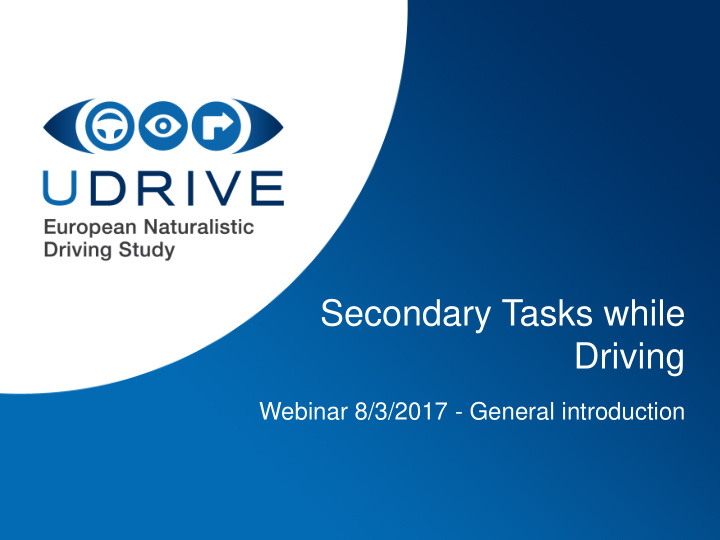



Secondary Tasks while Driving Webinar 8/3/2017 - General introduction
Agenda 11:30 Introduction to the UDRIVE project and to the work on secondary tasks (Oliver Carsten, ITS-Leeds) 11:40 Analytical approach: major research questions and data extraction (Oliver Carsten, ITS-Leeds) 11:55 Q&A 12:05 Auto detection of secondary tasks (Laurette Guyonvarc'h, LAB) 12:20 Q&A 12:30 Wrap up 12:35 End 2
To raise a question during or after a presentation 3
What are Naturalistic Driving Studies? Observing drivers in their natural habitat with automated equipment
Hours of d ata collected: over 66,800 hours 30 40 30 One DAS 30 20 One Database 30 40
Camera Positions – Cars • Front view wide (3 cameras) • Driver view • Driver’s feet Cabin view • • Over-the shoulder view 7 cameras
UDRIVE: Sensor data
UDRIVE: Analysis tool and annotation
Major focus of the work on secondary tasks • Who? • Where? • What? • When? • How? 9
Major focus of the work on secondary tasks • Who is doing it? • Where are they doing it? • What are they doing? • When, i.e. in what circumstances, are they doing it? • How are they managing the situation? • So another way to look at it is that we are examining to what extent drivers are successfully self-regulating 10
Analytical Approach Oliver Carsten (ITS-Leeds)
Data extraction • Step 1 is to identify when the secondary tasks start and end • Done from manual coding of videos of driving • For a sample of trips for all the car and truck participant drivers 12 3/8/2017 Event name here (Edited in the footer section).
Coding of secondary task type • The main focus here on use of mobile phones and electronic devices • Each secondary task is broken down into sub-tasks, e.g.: – Reaching for phone – Interacting with phone (pressing areas on screen, dialling, texting) – Talking – Reading the screen – Glancing at the phone momentarily – Talking or listening on a hands-free device 13
Coding of environment • Partly manual, e.g.: – Intersection approach – Crest approach • Partly automated – Road type – Day, night, dawn, dusk – Dry or rain (from wipers) – Traffic density (from sensor) 14
Prioritised Research Questions (1) What are the key factors influencing the willingness of drivers to deliberately engage in secondary tasks such as phone conversation, dialling or texting? What is the prevalence of secondary task activity in normal driving? What specific types of secondary tasks do drivers typically engage in? To what extent do driving task complexity and secondary task complexity influence the decision to engage in secondary tasks while driving? To what extent is the willingness to engage in secondary tasks while driving dependent on age, gender and cultural factors 15
Prioritised Research Questions (2) How do drivers adapt ongoing secondary task activities to the evolving driving situation? To what extent do drivers adapt their safety margins before, during and after performing secondary tasks? 16
Prioritised Research Questions (3) To what extent can an individual’s willingness to engage in secondary tasks, and its effects on risk and driving performance, be predicted from psychological tests? To what extent can the general willingness to engage in secondary tasks and specific scheduling characteristics (e.g. extreme glances) be predicted from psychological tests? Which personality dimensions have the strongest predictive value 17
Q&A 18
Further questions / Contact: • Oliver Carsten (ITS-Leeds) – o.m.j.carsten@its.leeds.ac.uk • Laurette Guyonvarc'h (LAB) – laurette.guyonvarch@lab-france.com • Jonas Bärgman (SAFER) – jonas.bargman@chalmers.se 19
REGISTRATION OPEN! Final event The UDRIVE Experience June 7, 2017 6th International Symposium Naturalistic Driving Research June 8 – 9, 2017 More information? http://ndrsymposium.com
Recommend
More recommend